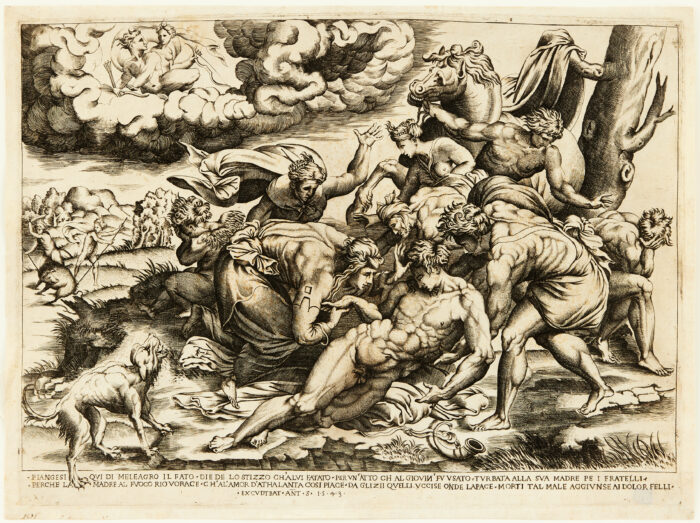The Death of Meleager
Francesco Salviati (Italy 1510-1563) (after), by Girolamo Fagiuoli, Italy (active 1530-1574). “The Death of Meleager”. Engraving on laid paper, with an anchor in a circle watermark, S. 43.3×32.8 cm.
Bartsch 41 from the first state, of five, as published by Salamanca. 1543.
This print was formerly thought to be by Nicolas Beatrizet (France and Italy 1507-1565), though more recently it has been convincingly attributed to Girolamo Fagiuoli by Suzanne Boorsch and Bernard Barryte in Myth, Allegory and Faith, Cantor Arts Center, Stanford, 2015, page 110, catalogue number 71.
PROVENANCE
The collection of Engineer and Major Frank Bensow (1883-1969), with the ink stamp verso (Lugt 982c).
Viewers of this vigorous and sculptural engraving are invited into the scene by the extended paw of the hunting dog, which breaks out of the pictures frame at the lower left. The hound barks at a fractured frenzy of bulging muscles and twisting hair centered upon the dying man. The dense, claustrophobic composition heightens the terrible drama of the scene. The dying figure is the ancient Greek hero Meleager, and his story underscores the primacy of family loyalty in Greek culture. At his birth, the Fates decreed that Meleager would live only until a burning log was consumed. His mother removed the log from the fire to grant him immortality, but when he killed her brothers over a dispute relating to the Caledonian boar hunt (seen in the background), she threw the log back on the fire. Girolamo Faccioli was only recently suggested as the author of this print. A goldsmith as well as an engraver, his skill and training is evident in the forceful parallel lines that delineate the richly modeled forms. [note from St. Louis Art Museum]
